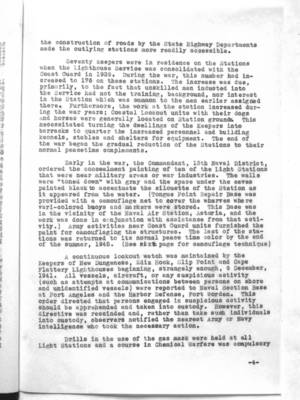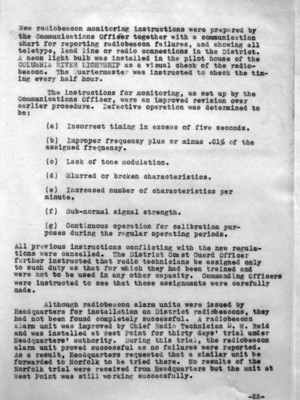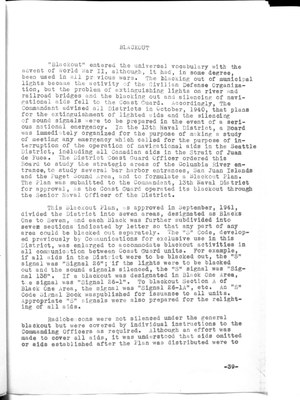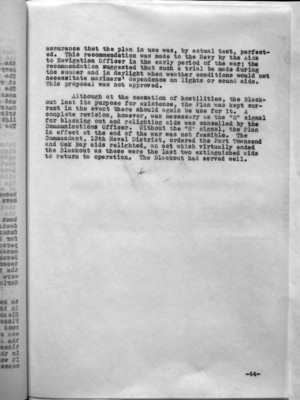Pages That Mention Communications
Coast Guard District narrative histories 1945
23
the construction of roads by the State Highway Departments made the outlying stations more readily accessible.
Seventy keepers were in residence on the Stations when the Lighthouse Service was consolidated with the Coast Guard in 1939. During the war, this number had increased to 176 on these stations. The increase was due, primarily, to the fact that unskilled men inducted into the Service had not the training, background, nor interest in the Station which was common to the men earlier assigned there. Furthermore, the work at the station increased during the war years; Coastal Lookout units with their dogs and horses were generally located on Station grounds. this necessitated turning the dwellings of the Keepers into barracks to quarter the increased personnel and building kennels, stables and shelters for equipment. The end of the war began the gradual reduction of the Stations to their normal peacetime complements.
Early in the war, the Commandant, 13th Naval District, ordered the concealment of ten of the Light Stations that were near military areas or war industries. The walls were "toned down" with gray and the space under the eaves painted black to accentuate the silouette of the Station as it appeared from the water. (Tongue Point Repair Base was provided with a camouflage net to cover the wharves where vari-colored buoys and markers were stored. This Base was in the vicinity of the Naval Air Station, Astoria, and the work was done in conjunction with assistance from that activity.) Army activities near Coast Guard units furnished the paint for camouflaging the structures. The last of the stations was returned to its normal peace time color by the end of the summer, 1945. (See sixth page for camouflage technique)
A continuous lookout adwatch was maintained by the Keepers of New Dungeness, Ediz Hook, Slip Point and Cape Flattery Lighthouses beginning, strangely enough, 6 December, 1941. All vessels, aircraft, or any suspicious activity (such as attempts at communications between persons on shore (such as attempts at communications between persons on shore and unidentified vessels) were reported to Naval Section Base at Port Angeles and the Harbor Defense, Fort Worden. This order directed that persons engaged in suspicious activity should be apprehended and taken into custody. However, this directive was rescinded and, rather than take such individuals into custody, observers notified the nearest Army or Navy intelligence who took the necessary action.
Drills in the use of the gas mask were held at all Light Stations and a course in Chemical Warfare was complusory
41
New radiobeacon monitoring instructions were prepared by the Communications Officer together with a communication chart for reporting radiobeacon failures, and showing all teletype, land line or radio connections in the District. A neon light bulb was installed in the pilot house of the COLUMBIA RIVER LIGHTSHIP as a visual check of the radiobeacon. The Quartermaster was instructed to check the timing every half hour.
The instructions for monitoring, as set up by the Communications Officer, were an improved revision over earlier procedure. Defective operation was determined to be:
(a) Incorrect timing in excess of five seconds.
(b) Improper frequency plus or minus .01% of the assigned frequency.
(c) Lack of tone modulation.
(d) Slurred or broken characteristics.
(e) Increased number of characteristics per minute.
(f) Sub-normal signal strength.
(g) Continuous operation for calibration purposes during the regular operating periods.
All previous instructions conflicting with the new regulations were cancelled. The District Coast Guard Officer further instructed that radio technicians be assigned only to such duty as that for which they had been trained and were not to be used in any other capacity. Commanding Officers were instructed to see that these assignments were carefully made.
Although radiobeacon alarm units were issued by Headquarters for installation on District radiobeacons, they had not been found completely successful. A radiobeacon alarm unit was improved by Chief Radio Technician D. W. Reid and was installed at West Point for thirty days' trial under Headquarters' authority. During this trial, the radiobeacon alarm unit proved successful as no failures were reported. As a result, Headquarters requested that a similar unit be forwarded to Norfolk to be tried there. No results of the Norfolk trial were received from Headquarters but the unit at West Point was still working successfully.
-22-
59
"Blackout" entered the universal vocabulary with the advent of World War II, although, it had, in some degree, been used in all previous wars. The blacking out of municipal lights became the activity of the Civilian Defense Organization, but the problem of extinguishing lights on river and railroad bridges and the blacking out and silencing of navigational aids fell to the Coast Guard. Accordingly, The Commandant advised all Districts in October, 1940, that plans for the extinguishment of lighted aids and the silencing of sound signals were to be prepared in the event of a serious national emergency. In the 13th Naval District, a Board was immediately organized for the purpose of making a study of meeting any emergency which called for the purpose of interruption of the operation of navigational aids in the Seattle District, including all Canadian aids in the Strait of Juan de Fuca. The District Coast Guard Officer ordered this Board to study the Strategic areas of the Columbia River entrance, to study several bar harbor entrances, San Juan Islands and the Puget Sound Area, and to formulate a Blackout Plan. The Plan was submitted to the Commandant, 13th Naval District for approval, as the Coast Guard operated its blackout through the Senior Naval Officer of the District.
This Blackout Plan, as approved in September, 1941, divided the District into seven areas, designated as Blacks One to Seven, and each Black was further subdivided into seven sections indicated by letter so that any part of any area could be blacked out separately. The "S" Code, developed previously by Communications for exclusive use in this District, was enlarged to accommodate blackout activities in all communication between Coast Guard units. For example, if all aids in the District were to be blacked out, the "S" signal was "Signal 26"; if the lights were to be blacked out and the sound signals silenced, the "S" signal was "Signal 138". If a blackout was designated in Black One Area, the signal was "Signal 26-1A", etc. An "S" Code Signal Book was published for issuance to all units. Appropriate "S" signals were also prepared for the relighting of all aids.
Radiobeacons were not silenced under the general blackout but were covered by individual instructions to the Commanding Officers as required. Although an effort was made to cover all aids, it was understood that aids omitted or aids established after the Plan was distributed were to
-39-
63
The District Liaison Officer suggested a system for the control of coastal lighthouses as employed by the Canadian Navy to be initiated in a similar way for U. S. Lighthouses. The Canadian Plan consisted of a broadcast three times a day at regular hours to all lighthouse keepers along the Coast. The system was divided into lettered plans; i.e., Plan "A" meant to keep lights burning bright, "B", submarine scare and all lights must be extinguished, etc. The District Coast Guard Officer did not accept this recommendation as the District plan then in use provided for extinguishment or relighting of any or all lights on a few minutes advance notice. The District system had the following advantages:
(a) It provided more positive communication and means of checking receipt of instruction.
(b) It provided greater security and more flexibility of instruction.
(c) It did not depend on any outside agency.
Proposals for dimming coastal lights were di(s)approved because of the unlighted gaps between lights which would have existed when the lights were dimmed.
A test blackout was held in March, 1942, for all Lifeboat and Light Stations. As a result of this test, it was decided that Seattle Radio Station, Westport, would, in the future, broadcast a whistle blast preceding the instructions for blackout. Upon hearing the whistle over the air, all personnel standing radio watches were instructed to copy the message which followed and notify their Commanding Officers. Because of the possibility that telephone communications between Lifeboat and Light Stations might not be available at the time a blackout was ordered, all Light Stations which were radio-equipped were ordered to maintain a radio watch during the entire time the light was burning.
Revisions of the Blackout Plan^1 were made periodically to keep each section of the District cognizant of any changes in that particular area. After each revision, holders of Blackout Plans were ordered to destroy copies of previous Plans by burning. In 1945, a complete coverage of state railroad bridges, covering the area as far east as the Cascades, was completed and included in the Plan. It was advised by the Aids to Navigation Officer that similar blackout regulations be continues during peace time so that any confusion, in the event of a similar emergency, might be eliminated. It was further recommended that tests of the Plan be made occasionally be effecting a total blackout as there was no
-43-
64
assurance that the plan in use was, by actual test, perfected. This recommendation was made to the Navy by the Aids to Navigation Officer in the early period of the war; the recommendation suggested that such a trial be made during the summer and in daylight when weather conditions would not necessitate mariners' dependence on lights or sound aids. This proposal was not approved.
Although at the cessation of hostilities, the Blackout lost its purpose for existence, the Plan was kept current in the even there should again be use for it. A complete revision, however, was necessary as the "S" signal for blacking out and relighting aids was cancelled by the Communications Officer. Without the "S" signal, the Plan in effect at the end of the war was not feasible. The Commandant, 13th Naval District, ordered the Port Townsend and Oak Bay aids relighted, an act which virtually ended the Blackout as these were the last two extinguished aids to return to operation. The Blackout had served well.
-44-




